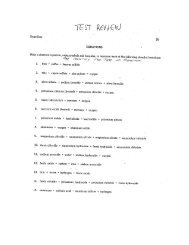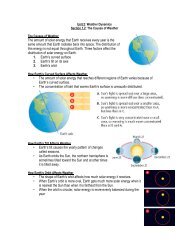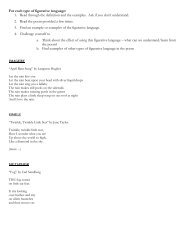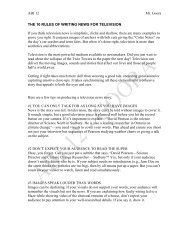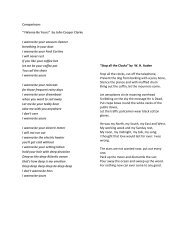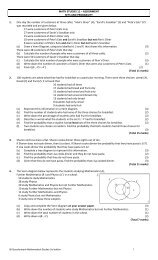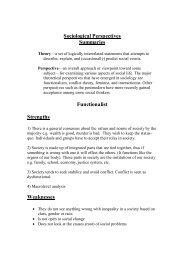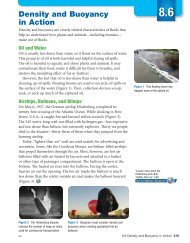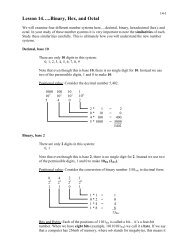Famous Trials Project - HRSBSTAFF Home Page
Famous Trials Project - HRSBSTAFF Home Page
Famous Trials Project - HRSBSTAFF Home Page
Create successful ePaper yourself
Turn your PDF publications into a flip-book with our unique Google optimized e-Paper software.
<strong>Famous</strong> <strong>Trials</strong> <strong>Project</strong><br />
English 10 Due:<br />
I. Doucette<br />
Inherit the Wind is based on the famous Scopes Trial of 1925. For this project, your job<br />
is to research another famous trial (preferably, one from the either the 20 th or 21 st<br />
century). Two people (or pairs) cannot do the same trial so you will need to sign up to<br />
do the trial you have chosen. <strong>Trials</strong> will be assigned on a first come, first served basis.<br />
You may want to look at the “<strong>Famous</strong> <strong>Trials</strong>” website (<br />
http://www.law.umkc.edu/faculty/projects/FTRIALS/FTRIALS.HTM) as a starting point,<br />
but this is only a starting point. The object of this exercise is for you to understand the<br />
issues and outcome of another trial well enough to deliver a 5 minute discussion about it.<br />
Be careful not to plagiarize.<br />
Your presentation will include the following information delivered in a clear way.<br />
1. A brief summary of the case, including:<br />
the crime<br />
the defence<br />
prosecution<br />
judgement<br />
sentence<br />
2. Also include the following:<br />
The media’s role in handling the case<br />
Whether or not you thought the verdict was fair<br />
Aftermath (if any) of the case<br />
Why this case is “famous”<br />
Any connection to Inherit the Wind?<br />
You must have a visual display to accompany and perhaps guide your talk. This can<br />
be a poster, a model, a video, a PowerPoint presentation, or another form of visual<br />
display.<br />
This project may be done in pairs or by a single person.<br />
You will be given two classes to research and prepare your project.<br />
Value:<br />
Presentation/Discussion – 12 points<br />
Visual Display – 8 points<br />
Please note the following important information:<br />
You are not to read from notes (although you may refer to them)<br />
You are to speak loudly, clearly, and slowly.<br />
You are to maintain eye contact with the class, not just the teacher or your<br />
visual display.
Organization<br />
Subject<br />
Knowledge<br />
Eye Contact/<br />
Elocution<br />
Visual<br />
Neatness/<br />
Organization<br />
Audience cannot understand<br />
presentation because there is<br />
no sequence of information.<br />
<strong>Famous</strong> <strong>Trials</strong> <strong>Project</strong> Presentation Rubric<br />
Adapted from Rubric Developed by Information Technology Evaluation Services, NC Department of Public Instruction<br />
I. Doucette<br />
1 2 3 4 Total<br />
Student does not have grasp of<br />
information; student cannot<br />
answer questions about subject.<br />
No connection made to Inherit<br />
the Wind.<br />
Student reads all of report with<br />
no eye contact.<br />
Student mumbles, incorrectly<br />
pronounces terms, and speaks<br />
too quietly for students in the<br />
back of class to hear. Vocal<br />
fillers, adaptors, and movement<br />
are used to such an extent that<br />
they completely distract<br />
audience from presentation.<br />
Little to no use of positive non<br />
verbal behaviours.<br />
Audience has difficulty following<br />
presentation because student<br />
jumps around.<br />
Student is uncomfortable with<br />
information and is able to<br />
answer only rudimentary<br />
questions. Superficial<br />
connection made to Inherit the<br />
Wind.<br />
Student occasionally uses eye<br />
contact, but still reads most of<br />
report.<br />
Student's voice is low. Student<br />
incorrectly pronounces terms.<br />
Audience members have<br />
difficulty hearing presentation.<br />
Attempts to make positive use<br />
of eyecontact, gestures,<br />
posture, rate, volume, tone, and<br />
vocal variety<br />
Vocal fillers, adaptors, and<br />
distracting movement detract<br />
from presentation.<br />
<strong>Famous</strong> <strong>Trials</strong> <strong>Project</strong> Presentation Rubric<br />
Student presents information in<br />
logical sequence which audience can<br />
follow.<br />
Student is demonstrates adequate<br />
content knowledge and expected<br />
answers to all questions, but fails to<br />
elaborate. Strong connection made to<br />
Inherit the Wind.<br />
Student maintains eye contact most<br />
of the time but frequently returns to<br />
notes.<br />
Student's voice is clear. Student<br />
pronounces most words correctly.<br />
Most audience members can hear<br />
presentation. Eyecontact, gestures,<br />
posture, rate, volume, tone, and vocal<br />
variety combined with the relative<br />
absence of vocal fillers, adaptors, and<br />
distracting movement enhances<br />
presentation<br />
Student presents information in<br />
logical, interesting sequence which<br />
audience can follow.<br />
Student demonstrates full knowledge<br />
(more than required) and answers all<br />
class questions with explanations and<br />
elaboration. Significant connection<br />
made to Inherit the Wind.<br />
Student maintains eye contact with<br />
audience, seldom returning to notes.<br />
Student uses a clear voice and<br />
correct, precise pronunciation of<br />
terms so that all audience members<br />
can hear presentation. Eyecontact,<br />
gestures, posture, rate, volume, tone,<br />
and vocal variety combined with the<br />
absence of vocal fillers, adaptors, and<br />
distracting movement enhances<br />
presentation<br />
Total Points: /12<br />
1 2 3 4 Total<br />
Student visual is superfluous, does<br />
not support the presentation, or is not<br />
present.<br />
The visual display is not neatly done<br />
and either detracts from the<br />
presentation or is unrelated to it.<br />
Visual is composed of material that<br />
supports the presentation very little.<br />
The visual display has some<br />
organization and an attempt was<br />
made to present the visual neatly.<br />
Visual display somewhat<br />
relates to or supports the<br />
presentation.<br />
The visual is somewhat<br />
organized with attention paid<br />
to detail and neatness.<br />
Visual directly relates to the presentation’s<br />
subject matter and reinforces the presentation.<br />
The visual is very well organized. It is makes<br />
logical sense. A lot of effort was put into<br />
presenting the visual in a neat manner.<br />
Total Points: /8
I. Doucette<br />
/20points



